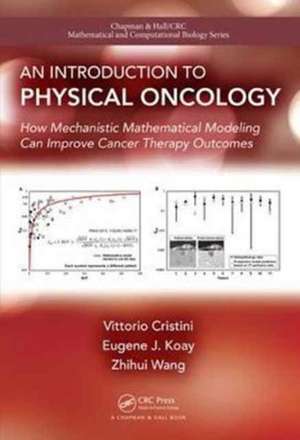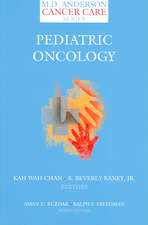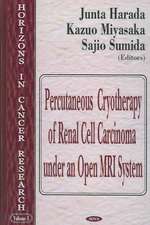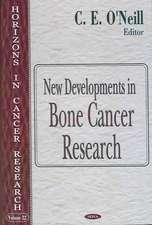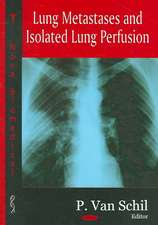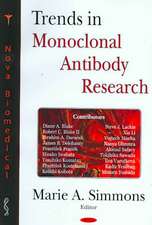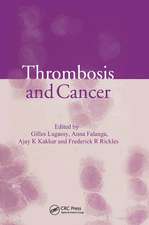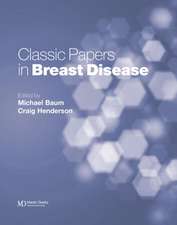An Introduction to Physical Oncology: How Mechanistic Mathematical Modeling Can Improve Cancer Therapy Outcomes: Chapman & Hall/CRC Mathematical Biology Series
Autor Vittorio Cristini, Eugene Koay, Zhihui Wangen Limba Engleză Hardback – 6 iul 2017
This book introduces the emerging field of physical oncology to a general audience, with a focus on recent breakthroughs that help in the design and discovery of more effective cancer treatments. It describes how novel mathematical models of physical transport processes incorporate patient tissue and imaging data routinely produced in the clinic to predict the efficacy of many cancer treatment approaches, including chemotherapy and radiation therapy. By helping to identify which therapies would be most beneficial for an individual patient, and quantifying their effects prior to actual implementation in the clinic, physical oncology allows doctors to design treatment regimens customized to each patient’s clinical needs, significantly altering the current clinical approach to cancer treatment and improving the outcomes for patients.
| Toate formatele și edițiile | Preț | Express |
|---|---|---|
| Paperback (1) | 432.34 lei 6-8 săpt. | |
| CRC Press – 13 dec 2021 | 432.34 lei 6-8 săpt. | |
| Hardback (1) | 499.33 lei 6-8 săpt. | |
| CRC Press – 6 iul 2017 | 499.33 lei 6-8 săpt. |
Preț: 499.33 lei
Preț vechi: 697.18 lei
-28% Nou
Puncte Express: 749
Preț estimativ în valută:
95.58€ • 103.85$ • 80.34£
95.58€ • 103.85$ • 80.34£
Carte tipărită la comandă
Livrare economică 22 aprilie-06 mai
Preluare comenzi: 021 569.72.76
Specificații
ISBN-13: 9781466551343
ISBN-10: 1466551348
Pagini: 204
Ilustrații: 129
Dimensiuni: 178 x 254 x 18 mm
Greutate: 0.59 kg
Ediția:1
Editura: CRC Press
Colecția Chapman and Hall/CRC
Seria Chapman & Hall/CRC Mathematical Biology Series
ISBN-10: 1466551348
Pagini: 204
Ilustrații: 129
Dimensiuni: 178 x 254 x 18 mm
Greutate: 0.59 kg
Ediția:1
Editura: CRC Press
Colecția Chapman and Hall/CRC
Seria Chapman & Hall/CRC Mathematical Biology Series
Cuprins
What Should Be Modeled in Cancer: Milestones for Physical Models. Developing More Successful Cancer Treatments with Physical Oncology. Mathematical Pathology. Mathematical Modeling of Drug Response. Prediction of Chemotherapy Outcome in Patients. Clinical Management of Pancreatic Cancer. Application of Cancer Physics in the Clinic. Tumor Morphological Behavior and Treatment Outcome. Mechanistic Model of Tumor Response to Immunotherapy. Perspectives on Physical Oncology and Future Directions
Recenzii
"The application of concepts and tools from the physical sciences will fundamentally change our understanding of cancer. These novel insights will impact the way we diagnose malignant tumors and, ultimately, they should lead to new and patient-specific paths to treat the disease more successfully. The authors are at the forefront of this most promising endeavor and they have produced a book that, ranging from chemotherapy response to immunotherapy modeling, highlights both critical research accomplishments and early clinical applications. This up-to-date book should be required reading for everyone interested in applying cutting-edge data-driven modeling to the field of oncology."
—Thomas S. Deisboeck, MD MBA, Harvard Medical School
"This book provides an important introduction to the emerging field of physical oncology. It examines cancer growth and treatment outcomes in the context of physical and biological processes across microscopic and macroscopic scales. The work is at the forefront of the convergence between physical science and cancer research. Seminal work by the authors and their collaborators from medicine, biology, engineering, mathematics, and physics discussed in this book includes the development of "master equations" from first principles to quantify penetration of free drugs and nanoparticles across tumor tissue, and relating these ideas to their potential for impact on patients. This book is a "must-read" for researchers interested in applying principles of physical sciences to cancer biology."
—Anil K. Sood, MD, Departments of Gynecologic Oncology & Reproductive Medicine and Cancer Biology, UT M. D. Anderson Cancer Center
"This timely book presents and discusses a range of highly promising, clinically relevant mathematical models of cancer progression and treatment. The authors use bio-physical laws informed by biological measurements to describe the processes of tumor growth and drug transport in tumor tissue to make predictions of outcomes for patients. Their work is informed by quantitative measurements from standard-of-care diagnostics, such as CT, histopathology, and MRI. In doing so, they seek to render individualized rubrics for each patient, based on his or her specific tumor characteristics. This provides a fresh take on the modern concept of "Precision Medicine." The pioneering models described here can pave the way for new, accurate clinical decision tools, which can be used by physicians to predict and thus optimally plan current and new individualized treatment strategies for patients."
—Anirban Maitra, MBBS, Sheikh Khalifa Bin Zayed Al Nahyan Distinguished University Chair in Cancer Research, UT M. D. Anderson Cancer Center
"During the past decade, innovative researchers have applied principles of engineering and physics to cancer research, in an emerging field known as physical oncology. This multidisciplinary research effort has led to encouraging results towards a better understanding of different aspects of cancer biology and oncology, from quantitative understanding of tumor growth and progression to improved detection and the treatment of cancer. This book introduces and discusses the advances made at the interface of engineering/physical sciences and oncology and explores the new frontiers in this field. The chapters are well written and I am especially impressed by the approach to developing accurate mathematical predictions of tumor drug response in experiments and in patients. I think this book is a significant contribution towards the biomedical community's efforts to improve its quantitative understanding of the treatment of cancer. I hope the book will encourage more scientists to enter the field of physical oncology."
—Sanjiv Sam Gambhir, MD, PhD, Stanford University School of Medicine
—Thomas S. Deisboeck, MD MBA, Harvard Medical School
"This book provides an important introduction to the emerging field of physical oncology. It examines cancer growth and treatment outcomes in the context of physical and biological processes across microscopic and macroscopic scales. The work is at the forefront of the convergence between physical science and cancer research. Seminal work by the authors and their collaborators from medicine, biology, engineering, mathematics, and physics discussed in this book includes the development of "master equations" from first principles to quantify penetration of free drugs and nanoparticles across tumor tissue, and relating these ideas to their potential for impact on patients. This book is a "must-read" for researchers interested in applying principles of physical sciences to cancer biology."
—Anil K. Sood, MD, Departments of Gynecologic Oncology & Reproductive Medicine and Cancer Biology, UT M. D. Anderson Cancer Center
"This timely book presents and discusses a range of highly promising, clinically relevant mathematical models of cancer progression and treatment. The authors use bio-physical laws informed by biological measurements to describe the processes of tumor growth and drug transport in tumor tissue to make predictions of outcomes for patients. Their work is informed by quantitative measurements from standard-of-care diagnostics, such as CT, histopathology, and MRI. In doing so, they seek to render individualized rubrics for each patient, based on his or her specific tumor characteristics. This provides a fresh take on the modern concept of "Precision Medicine." The pioneering models described here can pave the way for new, accurate clinical decision tools, which can be used by physicians to predict and thus optimally plan current and new individualized treatment strategies for patients."
—Anirban Maitra, MBBS, Sheikh Khalifa Bin Zayed Al Nahyan Distinguished University Chair in Cancer Research, UT M. D. Anderson Cancer Center
"During the past decade, innovative researchers have applied principles of engineering and physics to cancer research, in an emerging field known as physical oncology. This multidisciplinary research effort has led to encouraging results towards a better understanding of different aspects of cancer biology and oncology, from quantitative understanding of tumor growth and progression to improved detection and the treatment of cancer. This book introduces and discusses the advances made at the interface of engineering/physical sciences and oncology and explores the new frontiers in this field. The chapters are well written and I am especially impressed by the approach to developing accurate mathematical predictions of tumor drug response in experiments and in patients. I think this book is a significant contribution towards the biomedical community's efforts to improve its quantitative understanding of the treatment of cancer. I hope the book will encourage more scientists to enter the field of physical oncology."
—Sanjiv Sam Gambhir, MD, PhD, Stanford University School of Medicine
Descriere
This book introduces the emerging field of physical oncology, and includes recent breakthroughs in how novel mathematical models of physical transport processes incorporate patient tissue and imaging data routinely produced in the clinic to predict the efficacy of many cancer treatment approaches, including chemotherapy and radiation therapy.
Notă biografică
Vittorio Cristini, The University of Texas Health Science Center at Houston, USA.
Eugene Koay, MD Anderson Cancer Center, USA.
Zhihui Wang, The University of Texas Health Science Center at Houston, USA.
Eugene Koay, MD Anderson Cancer Center, USA.
Zhihui Wang, The University of Texas Health Science Center at Houston, USA.
